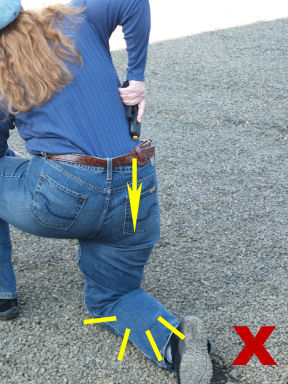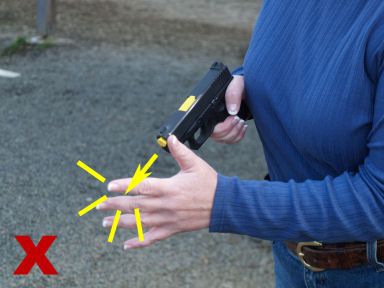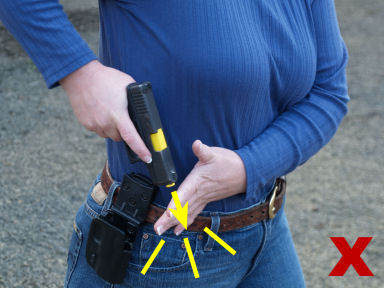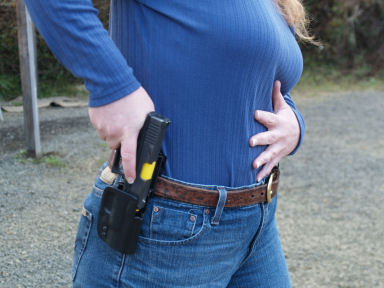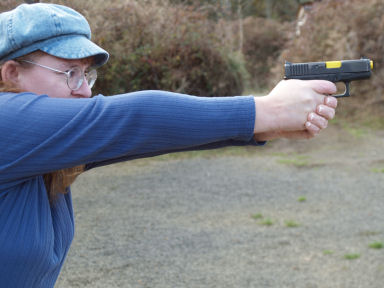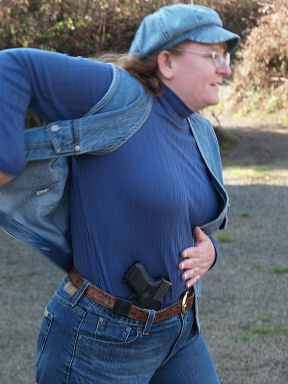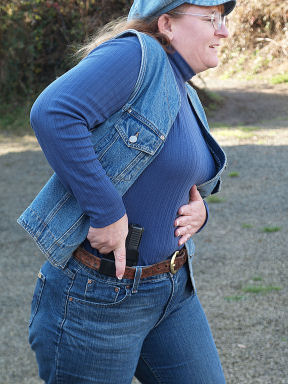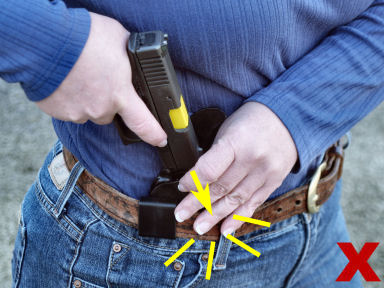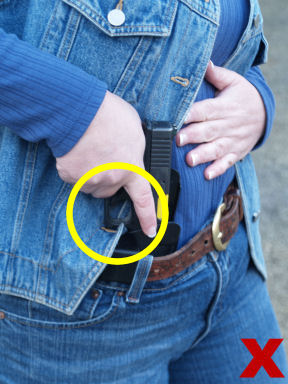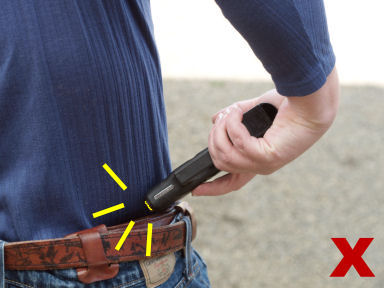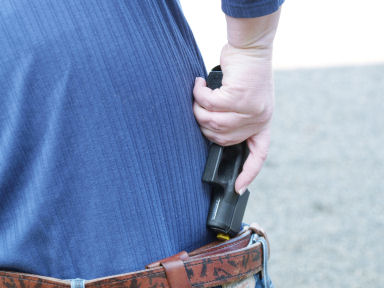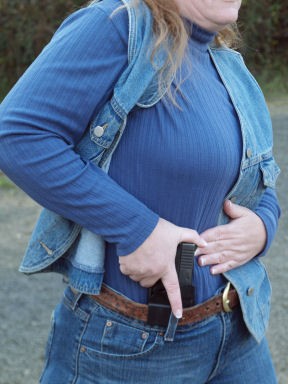Perhaps the most dangerous moment in any firearms class happens when new students begin using their holsters for the first time. But even experienced shooters can fall into some common safety pitfalls when using a holster. These pitfalls, and techniques for avoiding them, are shown in the photo essay below.
Dangers while drawing
| Danger: Although drawing from a kneeling position may be necessary during a fight for one’s life, such a draw always carries a risk of muzzling the lower leg during the drawstroke and again while reholstering. An unintended shot at this point would result in the shooter’s knee and lower leg being severely injured, perhaps crippled for life. The only way to avoid this danger is to habitually draw before kneeling, and to avoid reholstering until standing up. If you wish to practice drawing from the kneeling position, get a dummy gun for safety’s sake. |
|
| Danger: If the non-dominant palm is not habitually anchored on the abdomen during the drawstroke, there is a significant risk of sweeping it during the draw. An unintentional shot at this point would result in the shooter’s non-dominant hand being severely injured, perhaps crippled for life.
Some instructors recommend anchoring the wrist or elbow rather than the palm of the hand. This can be done safely during slowfire practice, but tends to become sloppy or fall apart dangerously as speeds are increased. |
|
| Danger: If the holster flops or twists during the draw, there is a strong but dangerous temptation to move the support hand in front of the holster as if to steady it. Preventing this temptation is one of many reasons a good solid belt is worth its weight in gold. |
|

How to stay safe: the basic draw
| The non-dominant palm anchors flat on the belly button while the dominant hand acquires a firing grip on the gun, with the trigger finger far outside the trigger guard. |
|
| As soon as the muzzle has cleared the holster, the shooter drops her elbow and the muzzle immediately aligns with the target even before the gun is raised. The sooner the muzzle is aligned with the target, the sooner the shooter can accurately fire from body index positions. |
|
| The shooter’s hands join at the midline, with the non-dominant hand coming from alongside or behind the gun as the hands meet. Do not allow the non-dominant hand to cross in front of the muzzle as the hand races to join the gun. |
|
| If the decision to fire has been made, the finger moves to the trigger. If the decision to fire has not yet been made, the trigger finger indexes alongside the frame. |
|
How to stay safe: drawing from concealment
| Cover garment should be flung far out of the way while non-dominant hand anchors to belly button. |
|
| The dominant hand must move quickly to the gun to avoid cover garment rebound. If the garment rebounds before the hand is on the gun, dangerous entanglements can result. |
|
Not shown: Another method to avoid cover garment rebound is to splay the gun-hand pinky finger during the drawstroke, running it along the shooter’s side to create a barrier against the garment’s return, while the remaining fingers obtain a normal grip on the gun.
Additional safety note: On the range, if you think your garment is getting tangled up during the drawstroke, stop immediately and fix the problem before continuing. If it happens during a real-life encounter, you’ll keep moving and cope with the tangle as best you can. But when practicing, there’s no particular reason to force the issue, and there’s a good reason not to: such tangles often result in dangerously out of control muzzle directions and dropped firearms.
Dangers while reholstering
| Danger: If you ordinarily carry in a collapsible holster, it’s safest to place the gun into it before putting the holster on your belt, because it is very difficult to open the mouth of a collapsed holster on the belt and place the gun in it without muzzling the non-dominant hand. Range practice with such a holster? Not worth the risk. Purchase a stiff-mouthed holster for practice. |
|
| Danger: Before reholstering, tuck loose clothing out of the way so it does not become entangled with the firearm and holster. If any resistance is felt during the reholstering sequence, stop immediately. Check for obstacles before continuing. |
|
| Danger: The classic pattern for a reholstering-related unintentional discharge involves a negligent trigger finger and too much speed. The gun fires the moment the mouth of the holster meets the shooter’s knuckle, especially inevitable if the shooter compounds her negligence by moving quickly. There is rarely or never any need to reholster in a hurry. Practice deliberately slowing down and changing mental gears before you reholster, taking time to be sure your trigger finger is where it ought to be. |
|
| Danger: Crooking the wrist while reholstering aims the muzzle of the gun directly into the core of the shooter’s body. An unintentional discharge at this point would be very, very ugly. |
|

How to stay safe: reholstering
| Keep your wrist straight when reholstering, especially if you have difficulty locating the mouth of your IWB holster. This helps you avoid muzzling straight into your torso.
When adapting to a new holster or carry position, there is nothing wrong with looking the gun into the holster. Later, you will want to holster by feel alone — but there’s no harm in using your eyes during the early part of the familiarization process, and it is somewhat safer. |
|
| To safely reholster, tuck the cover garment firmly into the armpit and pin it there with your upper arm. Keep the non-dominant palm anchored to the belly button to avoid the natural temptation to move it in front of the holster (and the gun’s muzzle). Maintain a firing grip on the gun, but keep the trigger finger far outside the trigger guard. Placing the thumb on the back of the slide may hold a Glock-type firearm firmly in battery while the gun enters a stiff holster; in other firearms types, similar thumb placement may allow the shooter to sense or prevent hammer movement.
Always move slowly when reholstering. There is no reason to hurry, and there are plenty of reasons to slow down. |
|







